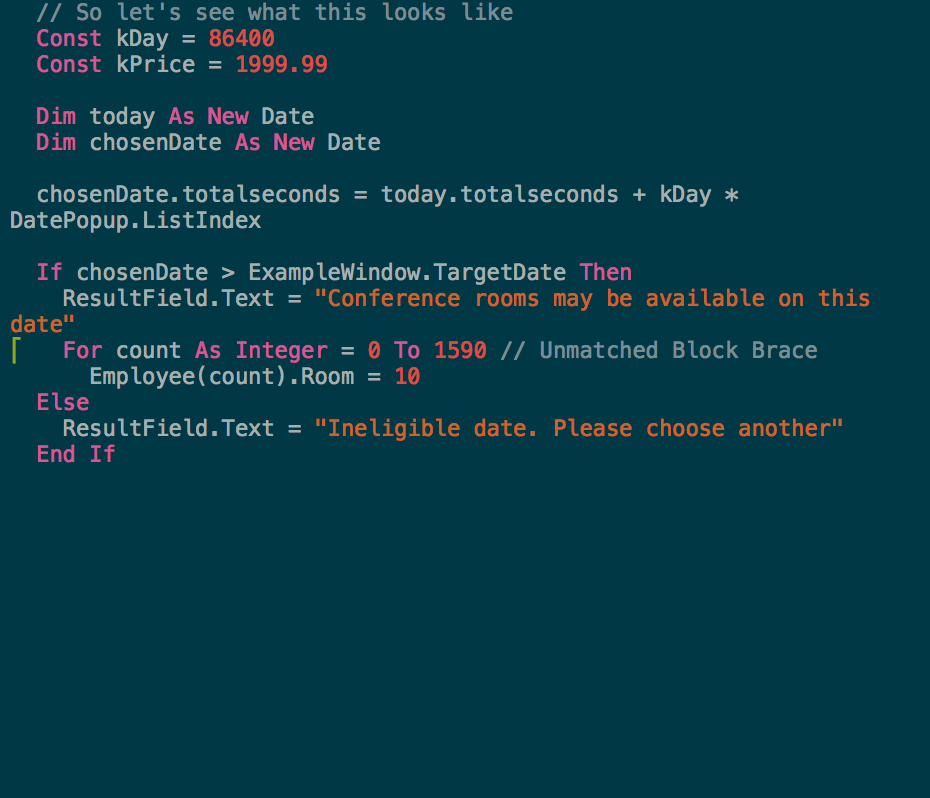In honor of Pi Day 2018, Xojo Pi licenses will be free! Xojo Pi licenses allow you to build console apps for Linux ARM for use with Raspberry Pi 2 and Raspberry Pi 3.
Comments closedCategory: Technology
As developers, we often like to have things set up and configured in our own way and our favorite IDE itself, Xojo, is certainly no exception. Xojo allows you to customize it in lots of way but today I want to talk about theming the IDE, or specifically the code editor.
Xojo has always had the ability to customize colors of tokens in the code editor. For example, you can open up Xojo’s Preferences and change the colors of keywords, strings, comments and much more, as well as the font and font size. Other than making things look pretty, there are practical reasons for doing all of this. You may find certain themes are easier on your eyes, especially as you age. Or you may want to have one color scheme for daytime, such as a light background with bright colors for the tokens, and a different color scheme for late night coding, such as a dark grey background with more subdued token colors.
Comments closedAn optimizer “improves” the IR, but that can mean a lot of different things. Improve could mean “run faster” or “use less memory”. Or perhaps you want to optimize for memory access time because CPUs are so fast it is sometimes more efficient to repeatedly calculate something rather than calculate it once, store it and access it later.
This is the sixth post in our Compiler series. Previous posts:
- LLVM Everywhere
- Compilers 101 – Overview and Lexer
- Compilers 102 – Parser
- Compilers 103 – Semantic Analyzer
- Compilers 104 – IR Generation
- Compilers 105 – Back End Overview
As I’ve written before, the FCC’s claim that rolling back Net Neutrality will result in more competition (which presumably will be better for consumers) is flawed because of the cost of the last mile. What that means, in summary, is that over the last 30 years various cable and telecom companies have bared the cost of laying all the cable/wire necessary to bring internet service to most of the homes and businesses in US cities. They did this because city governments were more than willing to trade the enormous cost of creating a citywide network for the provider having (in most cases) an effective monopoly on providing internet access.
This isn’t the first time a service or utility has evolved in this manner in the United States. The railroads, the telegraph and later telephone service were all networks that were developed in much the same way.
Comments closedViruses continue to be a big problem on Windows. As a result, anti-virus software can be a bit over-zealous about detecting what it believes to be apps that have viruses embedded within them. We have had reports over the years that apps made with Xojo are sometimes falsely identified as being infected with a virus. This sometimes occurs because the 32-bit Xojo compiler puts executable code in a location where the anti-virus software doesn’t expect to find it. We’ve seen this occur even when users are debugging apps from the IDE. Fortunately in that case, there’s a fairly easy solution.
Comments closedOnce the front end has done its work its time for the back end components to take over.
This is the fifth in our compiler series and the first on the back end. We covered the parts of the compiler that are called the front end in these posts:
- LLVM Everywhere
- Compilers 101 – Overview and Lexer
- Compilers 102 – Parser
- Compilers 103 – Semantic Analyzer
- Compilers 104 – IR Generation
Now that the Semantic Analyzer has verified that the code is actually correct and created syntax trees, it’s time to talk about IR generation.
This is the fourth post in our Compiler series. Other posts:
- LLVM Everywhere
- Compilers 101 – Overview and Lexer
- Compilers 102 – Parser
- Compilers 103 – Semantic Analyzer
The Semantic Analyzer is the real heart of the compiler. Its job is to validate code and figure out what the code actually means. Essentially it validates that the code is semantically correct.
This is the third post in our Compiler series. Previous posts:
Comments closedThe Xojo community is vibrant and active, with all kinds of clever, open-source software being created for iOS, desktop, web and Raspberry Pi. By my latest count, there are at least 80 open-source projects for Xojo on GitHub and other places!
Comments closedThere are about 80 Xojo-related open-source projects that I am tracking on the Xojo Dev Center: Open-Source Projects. I often have people ask me how they can make their own cool libraries and projects available on GitHub, so here’s a short tutorial.
Comments closed






